Dark winged fungus gnats are from the Sciaridae flies family. They’re typically found in moist environments and transmit plant fungal diseases, such as Furasium wilt and black root rot.
So, what exactly is dark winged fungus gnat? Dark-winged fungus gnats are small flying insects that prefer to stay in damp areas that have organic materials. These gnats are small, usually about 1 to 7 mm long, and have slender, dark bodies and wings. They infest potting mix, soil and other containers, and organic decomposition.
In this article, we’ll discuss more about the types of gnats, their identification, and ways to control them. This way, you can deal with them in a much better way!
What Type of Gnats Do I Have?
There are several dark-winged fungus gnats types, including:
Fungus or Houseplant Gnats
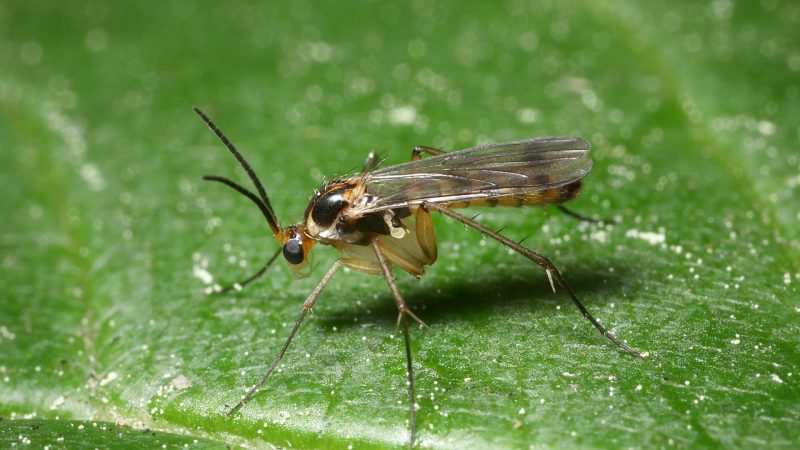
There are more than 1,000 species of gnats, but the most common is the fungus gnat. They’re also known as winter gnats, which are 1/16 of an inch to 1/8 of an inch in length.
Adults are grayish-black with long, transparent, or gray wings and visible veins. Their legs are long and they eat fungi, as well as roots of plants.
Fungus gnat eggs are smooth, nearly visible, oval, and shiny white. During their larval stage, they’re thread-like and white with no legs.
These flies can live up to a month and reproduce in houses with warm interiors. The female gnats can lay around 300 eggs on soils and take three days to hatch.
Drain Flies
Another gnat type you can find in your home is drain flies. Adults can grow up to ⅛ of an inch and are either gray or brown with light-colored wings.
They hang out in drains or sewers, which can block pipes. These insects reproduce in drains and sewers or where decaying organic matter is present.
Larvae take three days to mature and come in large numbers. They’re known to spread bacteria, but don’t usually transmit diseases to humans.
Related: Drain Flies Control: How To Get Rid of Drain Flies?
Midges
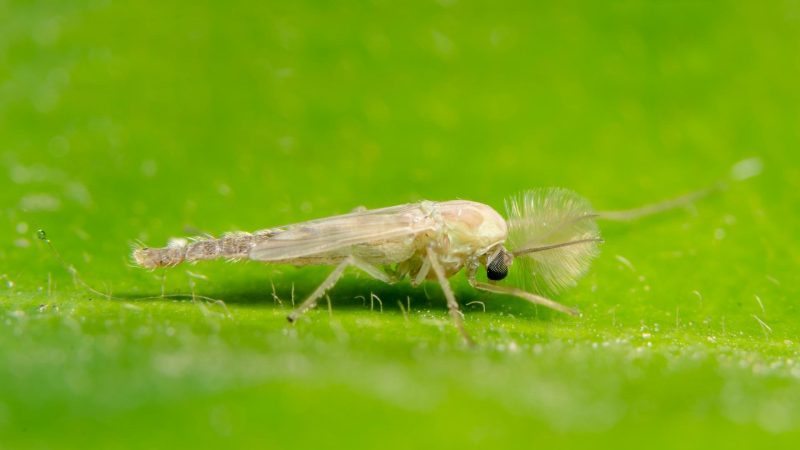
Midges live in swampy areas and extract blood from other animals and humans. They resemble mosquitoes and are gray in color with less than 1/8 of an inch in length.
Furthermore, they have segmented antennae, and females possess a long proboscis, which is used to extract blood. Midges live in aquatic habitats like streams and deep lakes.
These insects feed on nectar and sugary substances, and their life cycle can only last in less than three weeks.
Sand Flies
Sand flies or sand gnats are known for their sandy color and can grow up to ⅛ of an inch to 1/10 of an inch. Their bodies and legs have thick hairs with big, black eyes.
The female sand flies feed on blood before laying their eggs. Some of its species feed on mammals and reptiles and get their nutrients from the sugary nutrients of the plant’s nectar.
The completion of their life cycle is approximately 20-40 days, with 1-2 weeks intended for the hatching of the eggs into the larval stage. Meanwhile, the pupae turn into adults within 10 days.
Gall Gnats
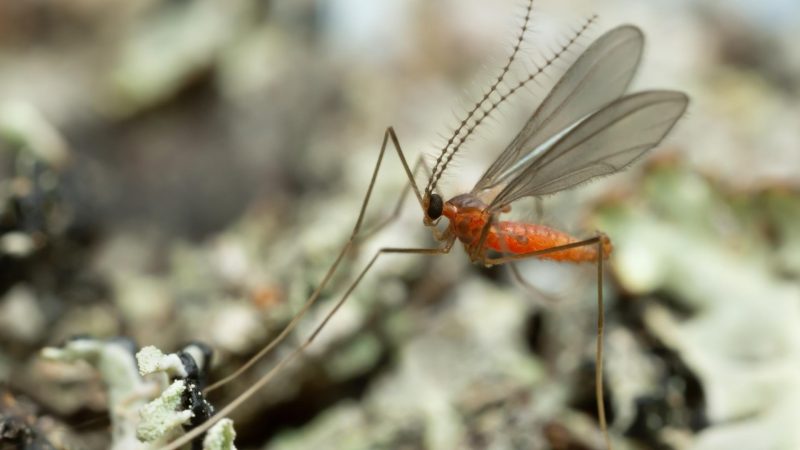
Gall gnats are small flies with the same appearance as mosquitoes. The only difference is that they don’t bite.
These insects inject their larvae into the sap of plants to get the nourishment they need. However, as a result, plants’ growth will be affected.
Gall gnats possess multi-jointed antennae with whorls of hair. Their wings have one main cross-vein and multiple longitudinal veins.
Their eggs are hatched into flattened maggots with tapered ends and are often brightly colored with yellow or red shades. On the other hand, the pupa is protected in a silk cocoon.
Furthermore, the female gnats produce over 400 eggs in 3 days. They consume blood for protein to help in egg production, pus, sebaceous secretions, and more.
Eye Gnats
Eye gnats, also known as grass flies, are tiny bugs that hang out near the humans’ and animals’ eyes, noses, and mouths. This is because they’re typically attracted to sweats or secretions in these areas.
Moreover, these tiny insects thrive in loose and sandy soil areas. Their life cycle primarily depends on food, temperature, and moisture available for them to survive.
In general, these gnats usually live up to 28 days. Although this is quite short, the female gnats can lay up to 400 eggs in only 2 to 3 days.
Females consume blood, pus, secretions, and animal sweat to gather protein for the pupa and larval stages. To deal with an infestation, make sure to first identify the type of gnat in your home.
After that, figure out methods to get rid of them permanently from your surroundings.
What Do Dark Winged Fungus Gnats Look Like?
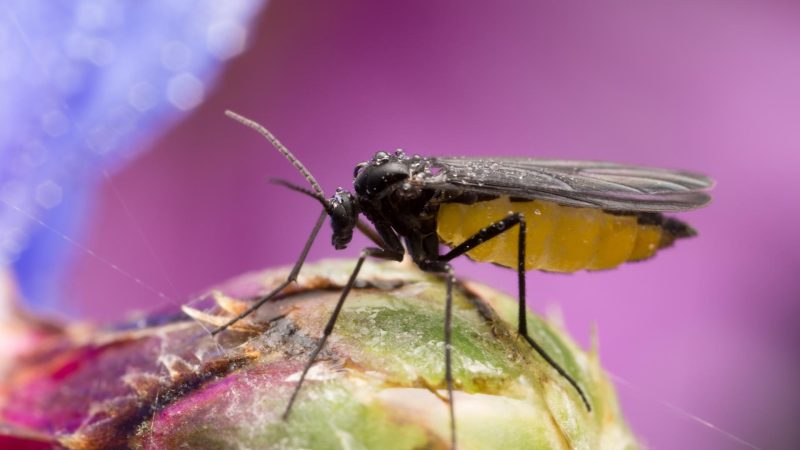
Dark winged fungus gnats are similar to small flies. They possess slender bodies, long legs, and long antennae. Their eggs are tiny and whitish-yellow in color.
Adults can grow up to ½ of an inch, but the average growth is around 1/16 of an inch to ⅛ of an inch.
Larvae, on the other hand, grow a bit larger than most adults with ¼ of an inch long. Signs of their infestation include:
- Slow growth
- Bright yellow leaves
- Tiny flies hovering below the plants
Why Am I Getting So Many Gnats in My House?
There are many gnats in your house because of the things present in your property that attract them. This includes:
- Houseplants
- Unsealed produce
- Fresh flowers
- Food spillage
- Overflowing garbage cans
On top of that, gnats also reside in sink drains because it’s where food residues are often collected. This place also provides them with breeding sites as food, water, and shelter are readily available at the sink drains.
Where Do Dark Winged Fungus Gnats Come From?
Dark winged fungus gnats are from outdoors and can be found in wet, decaying organic matter, such as:
- Mulch piles
- Compost piles
- Firewood piles that have been stored for a long time
How Long Do Fungus Gnats Live?
Adult fungus gnats can live approximately up to one to two weeks with a complete life cycle of 18 to 30 days. Meanwhile, the larvae feed for two weeks, then pupate close to the soil surface.
After three to seven days in the pupal stage, adults will surface and live for around eight days.
What Attracts Gnats?
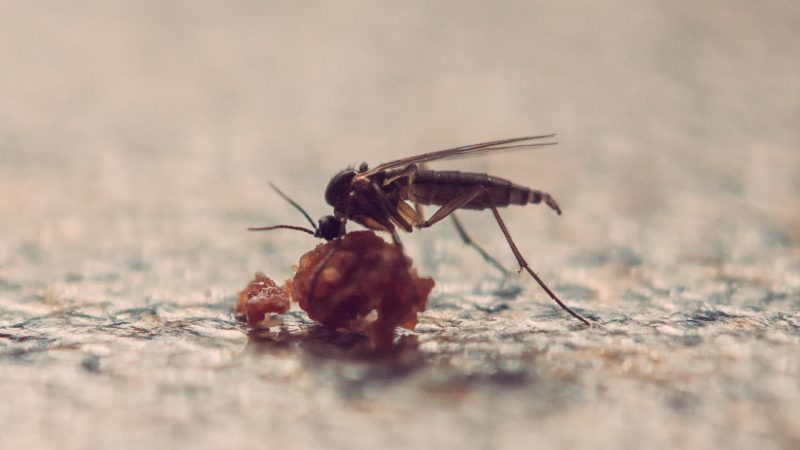
Within a home, gnats are attracted to:
- Houseplants
- Unsealed produce
- Fresh flowers
- Overflowing garbage cans
- Food spillage
They’re also attracted to sink drains as it provides them with shelter, food, water, and breeding sites.
What Do Gnats Eat?
Gnats eat a variety of food, including:
- Vegetables
- Fruits
- Rotting organic matter like firewoods, compost piles, and mulch piles.
- Slime created by damp, organic matter accumulated in poorly maintained garbage containers, garbage disposals, drains and other waste products sources.
What Is Dark Winged Fungus Gnat Larvae?
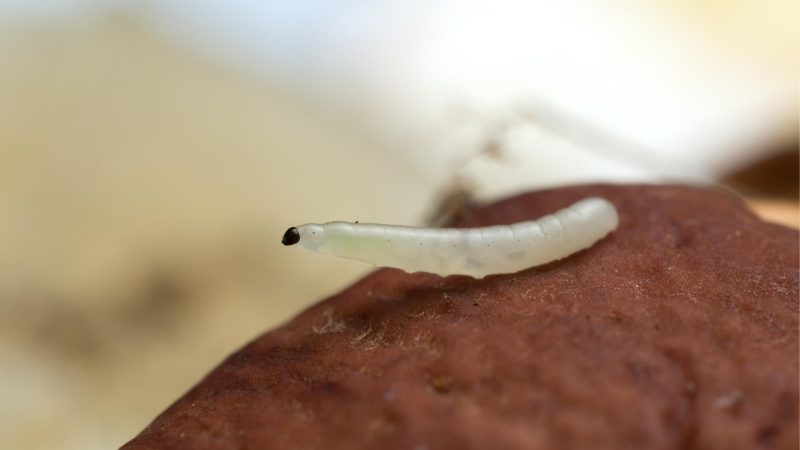
Dark winged fungus gnat larvae are white-bodied fungus gnats with black heads. They’re larger than adult gnats and can grow up to ¼ of an inch in length.
These larvae are legless and dwell in the soil to develop into pupae. They’re initially white but will darken in color as they begin to mature.
What Is the Best Way to Eliminate Fungus Gnats?
If there are tiny insects that keep on flying into your face when you water your plants, it’s time to think of ways to get rid of these fungus gnats.
Although these tiny insects don’t usually bite, female gnats can lay hundreds of eggs in the span of two to three days, affecting the health of your plants as they also feed on their roots.
Before you start, determine the gnat type you have and keep in mind that these insects resemble mosquitoes and hover around houseplants.
Step 1: Isolate the uninfected and infected plants.
When you bring in a new houseplant, ensure to keep it in a different room, away from the infected plants for at least a few weeks.
You can identify whether the tiny insects you’re seeing are fungus gnats by putting a ¼ of an inch slice of raw potato on the surface of the soil.
After a few days, inspect the underside of the potato. If you find tiny black-capped worms, then those minuscule insects hovering around under your plants are fungus gnats.
Step 2: Dry out the soil before the next watering.
Since fungus gnats like to lay their eggs in moist soil, make sure to let the pot’s soil dry out with a depth of 2 inches before you water your plants again. However, don’t let the soil dry out completely, as it can end up killing your plants.
Step 3: Use pyrethrin-based insecticide carefully.
If you don’t have pets at home, it’s best to spray your plants and the soil surface with a pyrethrin solution .
Pyrethrins are natural insecticides that are harmless to humans but reportedly harmful to pets, such as cats and fish.
Step 4: Add sticky traps.
Among the traps that are easiest to use are . These sticky traps are like sticky notes. All you have to do is put them horizontally on the plants’ soil surface.
These traps have glue coatings, capturing adult gnats effectively and the newly pupated ones.
These sticky traps come in diverse shapes and sizes. As much as possible, put fresh traps as needed until no more insects stick to them.
Step 5: Use apple cider vinegar.
If you don’t want to use insecticides, lure fungus gnats away from plants using apple cider vinegar. Just mix a few drops of dish detergent and half apple cider vinegar with half water in a jar.
Once done, put the container near the infected plant or on top of its soil. When gnats have been lured into the mix, they’ll eventually drown themselves and get killed in the process.
Step 6: Sprinkle at least ½ of an inch of sand over the soil surface.
Fungus gnats aren’t fond of sands because it dries up quickly and doesn’t contain rotting organic debris. So, it’s best to sprinkle at least ½ of an inch of sand on top of the soil surface to ensure that gnats won’t love to stay on your soil.
Prevent Future Infestations
To prevent future gnats infestations, always make sure to use sterilized soil to pot your plants. Moreover, keep the extra soil within a closed container right after opening its bag.
It’s also best to note not to mix compost into your potting soil unless it’s completely sterilized. On the other hand, you can also clean your compost or potting soil naturally by solarizing.
To do that, just put soil within a sealed plastic bag and flatten it to no more than eight inches deep. After that, place it on a raised site under the sun for at least one month.
What Insecticide Kills Fungus Gnats?
Currently, there are many insecticides that kill fungus gnats, and this includes:
Hydrogen Peroxide
Hydrogen peroxide kills fungus gnat on contact. Just use the ready-to-apply solution by drenching the soil. Once they come in contact with the hydrogen peroxide solution, gnats will get killed almost instantly.
Neem oil
Neem oil is best known to combat adult and larvae fungus gnats. All you have to do is shake and spray the ready-to-use solution to keep gnats at bay.
Pot Poppers
Pot poppers contain beneficial nematodes that get rid of fungus gnat larvae and other soil-dwelling insects. All you have to do is apply one pack sachet of pot poppers into a five-gallon pot.
Does Dipel Kill Fungus Gnats?
Dipel Pro DF is a biological insecticide, containing Bacillus thuringiensis var. Israelensis or BTI – a naturally developed bacteria that effectively kills fungus gnats.
Home-Made Remedies for Fungus Gnats
If you’re against the use of chemicals against fungus gnats, you can make your own home-made remedies instead, such as the following:
Cinnamon
Cinnamon spice is an excellent repellent against many insects and can even effectively get rid of some pests, like fungus gnats. Just sprinkle a thin layer of cinnamon into the surface of the soil and wait for the positive result.
Diatomaceous Earth
Simply referred to as DE, this remedy is made from the crushed remains of diatom fossils. To apply, sprinkle a thin layer of DE on potted plants’ soil when it’s dry to the touch. Its fragments cut through the pest’s protective wax coating, slowly dehydrating them to death.
Apple Cider Vinegar Homemade Fly Trap
To make this trap, take a 20-ounce soda bottle and cut off its top. After that, tape the top upside-down and fill it with apple cider vinegar and some drops of dish liquid soap.
The gnats will then fly into the opening and get stuck since they can’t navigate the funnel shape, making them drown, eventually.
Horticultural Sand
Horticultural sand is typically used as a soil aggregate and is effective against fungus gnats. To use, just add ¼ of an inch of horticultural sand over the soil, and it’ll discourage gnats from laying eggs or landing into the soil.
The Sticky Trap
One of the easiest and affordable methods to use against fungus gnats is using yellow sticky traps. These sticky traps are excellent in drawing gnats into the traps and getting them stuck there, leaving them to die eventually.
Related: How to Get Rid of Gnats in House? | 9 Effective Ways
Summary
Fungus gnats are not harmful to humans, but they can cause disturbances when they start to infest. Thus, it’s best to get rid of them right away while the problem isn’t in its worst state.
That way, you don’t have to use harmful chemicals to get rid of these pests. You can also call a pest control professional if you think you can’t handle the gnat issues on your own.
List of Sources
Shetlar, D. J., Andon, J. E. (2015). Fungus Gnats. Ohio State University Extension.
Bethke, J. A., Dreistadt, S. H. (2013). Fungus Gnats. University of California Agriculture & Natural Resources.
Alfuth, D., Liesch, P. J. (2021). Fungus Gnats on Houseplants. University of Wisconsin-Madison.
Theuret, D., Gerry, A. (2014). Moth or Drain Flies. University of California Agriculture & Natural Resources.
- How to Get Rid of Turtles | Proven Long-Term Solutions! - August 26, 2023
- How to Get Rid of Kingsnakes | Easy & Humane! - August 26, 2023
- How to Get Rid of Northern Water Snakes | Best Solutions and Preventative Measures! - August 19, 2023
